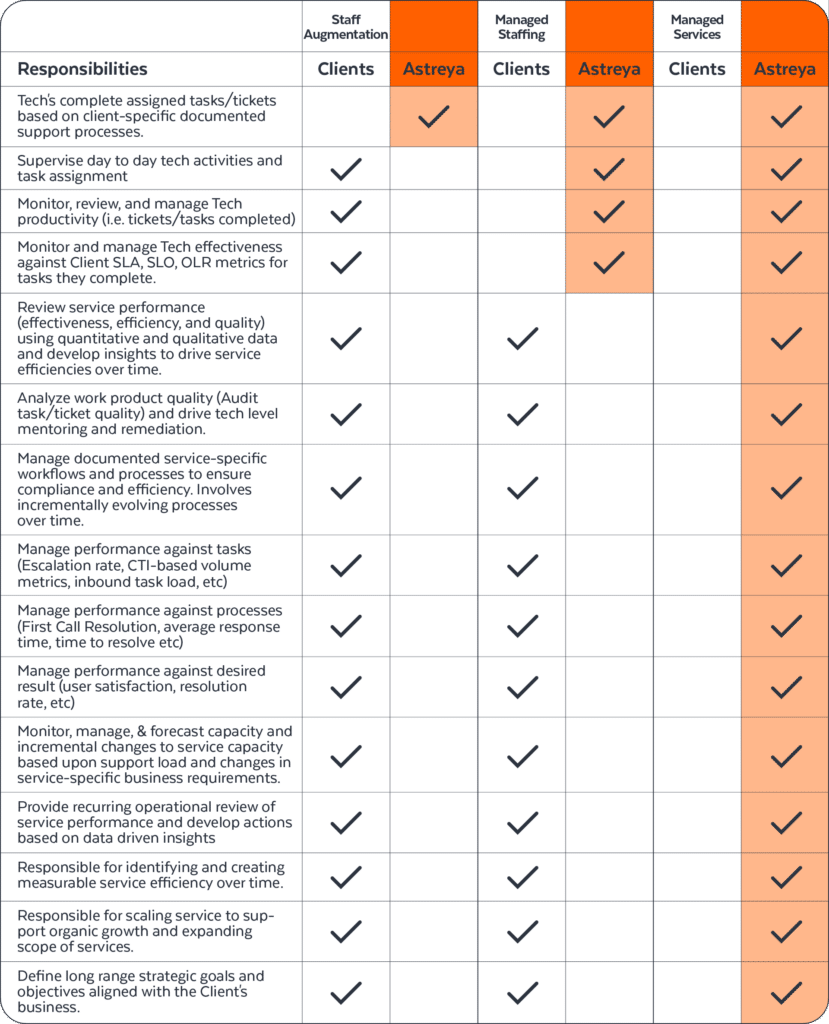
As businesses expand and technology becomes more integral to operations, IT support has become critical in ensuring smooth workflows. However, choosing the right one can be overwhelming with so many different models available. That’s why we’re breaking down the various IT support models to help you determine which best fits your business needs, goals, and budget. So let’s get started!
Staff Augmentation
Staff augmentation refers to hiring external IT professionals for a specific period to support the existing IT team in providing technical assistance to end-users. They have the necessary skills and expertise to handle particular IT issues to achieve business objectives or extend the capacity of an existing in-house team.
In utilizing this model, a service provider such as Astreya leverages the Client’s existing management and subject matter expertise to onboard Astreya workers to perform assigned work/tasks. The internal IT team is responsible for managing the overall support operation, overseeing the assigned task management and performance of Astreya resources, specifically regarding effectiveness, efficiency, and monitoring the quality of work.
The staff augmentation support model provides additional resources to help manage increased demand, special projects, or specialized skills unavailable internally.
Managed Staffing
With managed staffing, a service provider manages and supervises the external resources dedicated to the Client company. The service provider typically handles the recruiting, training, and payroll of the service desk staff, managing workflow and escalation processes and reporting on performance. The Client retains control over the management and direction of the service desk. The service provider may use its staff or a combination of internal and external resources to meet the organization’s needs. At Astreya, our contingent workers are supervised by an Astreya resource, who is focused on the day-to-day operations of implementing service-specific daily operational decisions made by the Client.
Managed staffing can be a cost-effective and efficient solution for organizations that want to ensure high-quality IT support without the burden of managing an internal IT team. The critical difference between managed staffing and managed service is that the Client retains control over the service desk’s management and direction in managed staffing. In contrast, in managed service, the service provider is responsible for managing the entire service desk operation.
Risk Analysis
There are also risks associated with using a staff augmentation or managed staffing support model for service desk support.
One potential risk is a lack of alignment with the organization’s culture and values, as external resources may not be fully integrated into the company’s culture and may not fully understand the organization’s goals and priorities. Additionally, there may be communication challenges, as external resources may not have the same familiarity with the organization’s processes and systems as internal employees.
Another potential risk is a lack of quality control, as external resources may not be held to the same standards as internal employees and may not have the same level of training or experience. This can lead to a lower quality of service and potentially negative impacts on the customer experience.
Finally, financial risks may be associated with staff augmentation and managed staffing, as external resources managed by a client versus a managed service provider may be more expensive than internal employees and may not provide the same level of ROI.
It is essential to carefully consider these risks, weigh them against the potential benefits of the different service desk support models, and choose a reputable service provider with a proven track record of success.
Managed Service
Managed Service is a comprehensive approach to IT support that involves outsourcing the entire service desk operation to a third-party service provider responsible for managing the IT support operation on behalf of the Client. They are accountable for meeting service level agreements (SLAs) defined by the Client and ensuring a high level of customer satisfaction.
Managed Service is an enterprise service model where service providers like Astreya are responsible for maintaining and anticipating the need for a range of processes and functions for improved operations and reduced budgetary expenditures. As a managed service provider, Astreya oversees all aspects of IT support effectiveness, efficiencies over time, and service quality, using qualitative and quantitative data beyond simple CSATs. This operation data and the associated insights are developed in weekly Ops reviews and communicated to the Client service owner monthly and quarterly business reviews with the Client.
Astreya managed services use demand-based pricing models that provide the client flexibility in scaling support horizontally and vertically based on business requirements;
- Cost Per Supported User (CPSU): Monthly recurring pricing based on the client organization’s number of supported users and usually used for user-facing support services.
- Cost Per Supported Device: Used for Data Center Operations (DCO), Network Operations Center (NOC), and AV/VC managed services. In the case of AV management, unit cost can be defined around supported conference rooms (enabled with AV/VC equipment).
- Cost Per Ticket: Broken down by the ticket category (Tier 1, Tier 2, etc.) to reflect the complexity and level of effort to resolve the ticket.
Here is a visual chart that breaks down the IT support offered per model to summarize the differences between the various service models and how to engage with Astreya Service Desk support.

Each model has its benefits and drawbacks when engaging with their support services. With the right understanding of each option, you can make the most effective decision for your organization’s IT needs. Whether you go with one of the three standard models or explore some custom options, Astreya will help ensure your business runs smoothly and effectively.